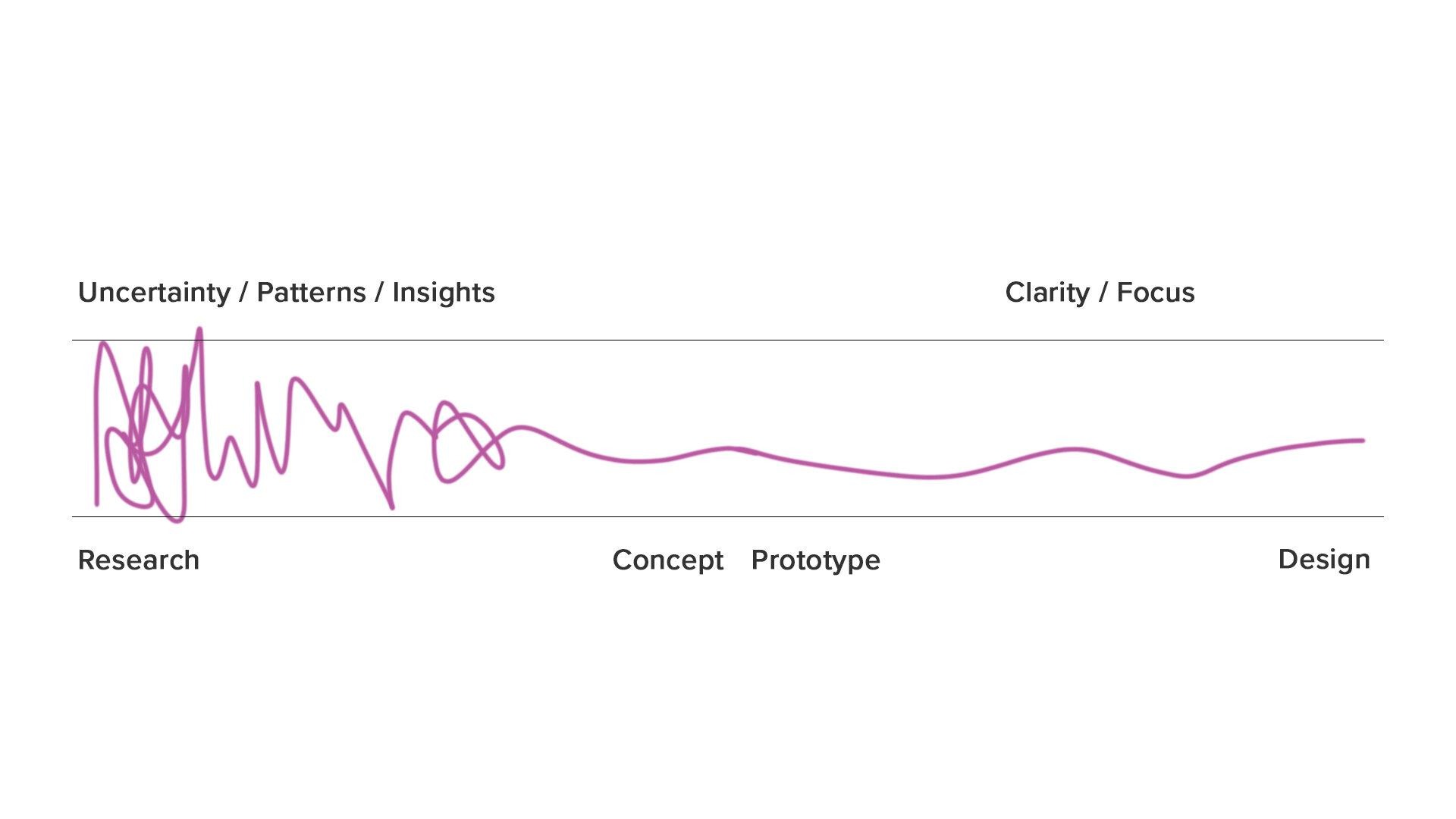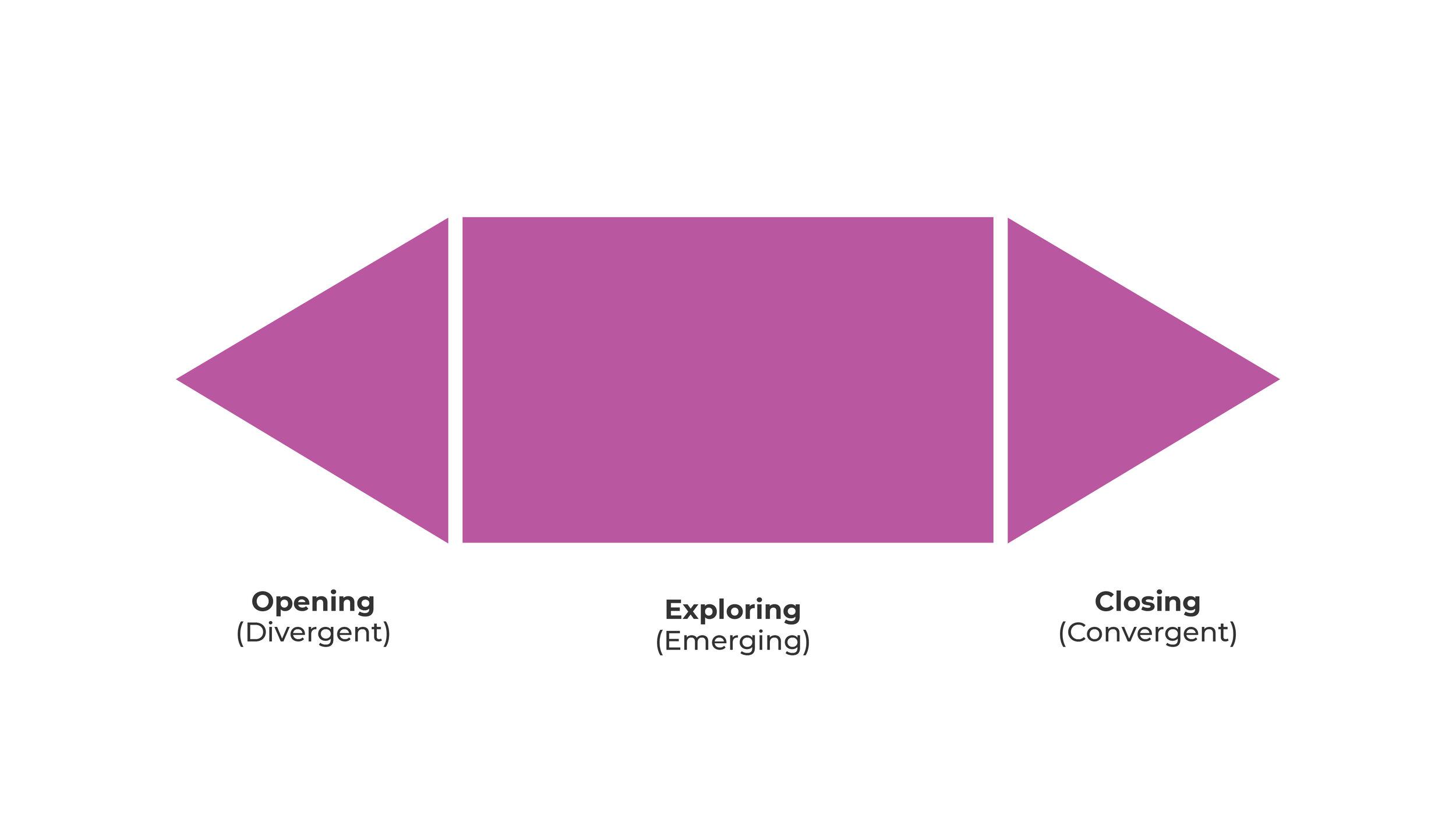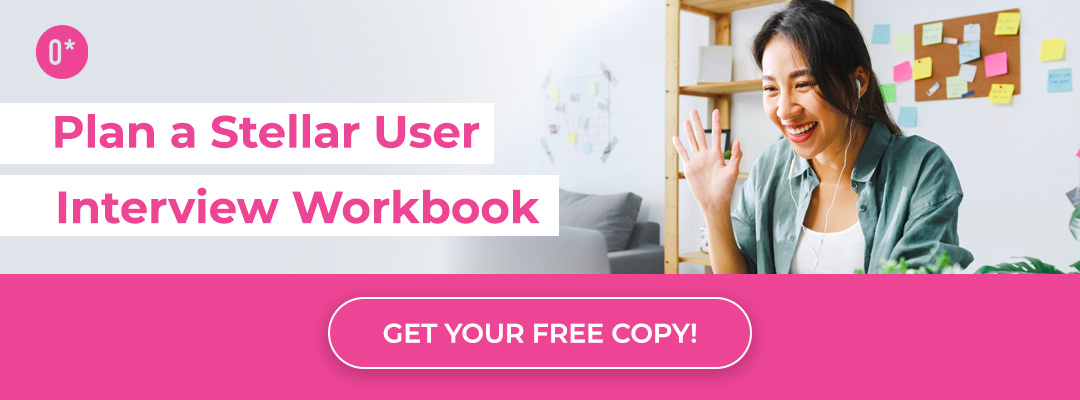In Part Two of our Design Thinking blog series, we explore the design thinking process in much more detail, laying out actionable methods to apply design thinking principles to service, product, and business challenges. In Part One, we defined the concept of design thinking and identified why it is so valuable for organizations today––now we’ll show you how to use it!
The “Fuzzy Front-End” of Design
When embarking on a design thinking project, there can be a lot of initial uncertainty and ambiguity around where the project is going––and sometimes this isn’t a lot of fun. Wading through data, determining what the problem is, identifying users’ feelings and challenges, incorporating stakeholder issues and agendas, and gathering information around business goals can all feel messy and overwhelming. People tend to become uncomfortable in this early stage. The famous “Design Squiggle” below, developed by Damien Newman, illustrates this process well. A lot of messiness takes place at the front end of a design initiative and smooths out over time as you get more information, analyze research, design concepts, prototype and test ideas, and then iterate and refine ideas into clear solutions (whether this solution is a new service, product/feature idea, or business concept).
Similarly, the general stages of a design thinking project involve both “diverging” and “converging”––or, opening your mind to new ideas, exploring solutions and testing, and then uniting around a final solution or design (see diagram below).
To diverge, you begin by talking to different types of people (like users, customers, employees, stakeholders, and so on), gathering input, looking closely at relevant business processes and trends, and collecting as much information as possible. This messy front-end of design then leads into an exploratory phase. Once you have a research question and have identified the actual problem, you ideate by coming up with lots of concepts and ideas. You refine these concepts, gather feedback, and refine again (over and over) as you slowly hone in (converge) on the best possible solution/design to close out the project. This idea of diverging and converging is also well represented in the UK Council’s Double Diamond, which we explore in our previous HCD blog series. And remember: if this process feels rife with ambiguity and more than a little complicated when you start out––you know you’re on the right track!
The Design Thinking Process
While there are many variations to the design thinking process out there, they all essentially boil down to the following FIVE important steps:
1. Empathize
This is the initial discovery phase of a project when you are trying to understand the broader landscape (“diverge”), users’ needs, motivations, challenges, and desires, business goals and challenges, and stakeholder perspectives. This stage is really about stepping into the shoes of those who use your products and services, and seeing things from their perspective. At this stage, you conduct research studies with real users to generate ideas and to explore their diverse challenges in order to identify new opportunities. To build empathy and better understand humans and their behaviours, we generally use the following tools:
-
Ethnographic Research
-
Empathy Mapping
This activity is a simple but effective way to understand people. Empathy mapping involves brainstorming how users think and feel, what they are saying, doing, hearing, and seeing in their day-to-day lives, as well as their pain points and motivations. Not only can a research team use empathy mapping to get a better grasp on their users, but any group of employees or stakeholders can get together and engage in empathy mapping to better comprehend how their team works. (Download our free Empathy Map Template to get started!) -
User Personas
User Personas are archetypes of the different users/customers that interact with an organization, ideally based on research. We dive deep into how to craft personas in our three-part blog series. The main idea is that you and your team can return to these personas again and again to keep their experiences and journeys top of mind.
2. Define
Once you understand all of the “actors” (stakeholders, users, employees, customers, and so on), it’s essential to frame––or reframe––the problem. Consider framing your problem as a question by starting it with the phrase “How might we…?” This is the best way to develop a clear user-centric problem statement. Here’s an example of what we mean:
-
Non User-Centric Statement: “We need to make our products digital so that we don’t lose customers and sales.”
-
User-Centric Statement: “How might we serve our customers better through more user-friendly digital products?”
3. Ideate
With your problem statement in hand and a thorough understanding of who users are and what they need, the real fun can begin! At this stage, it’s time to start generating ideas and concepts that could provide potential solutions to your problem. Think about what you could improve and how, and try to describe these ideas in as much detail as possible. Also, try to focus on quantity of ideas over quality of ideas in the beginning. The more the better––you’ll refine as you get more feedback. Once you have initial concepts, the ideate phase (sometimes referred to as the “design” phase) also includes the more detailed design of your solution. In the early stages, here are some tips to get the ideas flowing:
-
Brainstorming with a multidisciplinary team and people with diverse perspectives can generate some of the best ideas.
-
This process can be scrappy. Jotting down ideas or very rough sketches on paper is fine––this does NOT need to be expert sketching and app design.
-
Collaborative workshops are especially useful. Remember that:
-
All ideas are welcome. Everyone’s ideas are valid and wild ideas are even encouraged.
-
Defer judgement. Try not to shut down or judge anyone’s ideas. You never know who will bring up a solution that sparks the one “great” idea.
-
Build on the ideas of others. Consider using the word “AND” instead of “BUT”. For example, “that’s a good idea, and I think we could add XYZ…”
-
Stay focused. Stay on topic and be mindful of time constraints. Have a “parking lot” where you can park new ideas that don’t fit, but that shouldn’t be entirely forgotten.
-
Don’t rush to solutions and don’t forget to embrace ambiguity! As humans, our natural tendency is to try and solve problems immediately, but when brainstorming, we have to encourage each other to live in that uncomfortable space of not knowing.
-
4. Prototype & Test
Design thinking is really “learning by doing.” Make your ideas tangible with a prototype. This is essentially a mock-up of your solution; in the case of UX design this could be a clickable prototype through a tool like InVision, or it might mean developing a pilot program for testing out a service or business process. Begin with a rough prototype and refine your solution as you learn more. Try to gather feedback early and often. Prototyping should also involve evaluative research, where you’re gathering feedback on your ideas and solutions from real users and stakeholders in order to iterate and improve those ideas as you go.
View this post on Instagram
Click through to our Instagram post exploring our favourite UX prototyping tools…
5. Plan & Implement
After your ideas have been prototyped, tested, and refined (potentially several times), it’s important to put a plan or roadmap into place with prioritized tasks and features, task owners (to create accountability), and milestones. Minimum viable services and products (MVSs & MVPs) are great––you can focus on creating a smaller part of the solution well, get feedback, and move forward, rather than trying to create the entire solution upfront and perfectly. This phase can also include the actual implementation or “building” of the solution, such as agile software development.
Getting Started with Design Thinking
Wondering how you can begin applying design thinking principles immediately? Here are four concrete ways to effectively integrate design thinking into your internal workflows, teams, and/or business:
1. Shift your mindset.
-
Understand that you are NOT your users/customers. Sometimes when we talk to our clients, they say things like “I already know what my customers need!” When we ask them how they know this, they say “oh, well we did a survey a long time ago” or “I’m just like my customers, so I already understand what they would want…” These are dangerous waters to tread. Designers and stakeholders are not the customer! Users have their own motivations, goals, and challenges––and that’s where tools like personas come into play. Personas can help teams remember exactly who they are finding solutions for.
-
Embrace ambiguity and encourage experimentation among your teams and colleagues.
-
Make it safe to fail. Build an office culture where people feel safe coming up with ideas that might not work. Praise team members for going through the process, and try to focus more on what their learnings were, rather than the final solutions that may or may not have come out of it. For example, host a competition in the office, challenging teams to come up with new ideas––and instead of rewarding the best idea, reward the team with the most ideas (or something similar) Basically, try to shift the emphasis.
-
Embrace the incremental release. It can be helpful to move away from ALWAYS holding big product or service launches, and instead embrace smaller releases. This will allow you to get feedback sooner, iterate and implement more quickly.
2. Start empathizing.
-
Talk to your users, employees, customers, and stakeholders. Conduct user interviews or observations. Get to know them. For the most part, you’ll find that people are VERY happy to give their feedback (or complain about a service or product), and that they appreciate being asked in the first place. Ask “what would you like to see from us?” “What’s an ideal experience for you?” Gather as many details as you can this way.
-
Hone your listening skills. When talking to others, there’s often a tendency to bring in our own anecdotes and two cents. Try to pause and suppress the instinct to jump in. And yes…it might get a tad uncomfortable, but the person you’re talking to will usually think of things to add and keep talking––they just need the space and time to think.
-
Grab a blank empathy map template and get mapping with your team, colleagues, or users!
3. Question everything.
-
Turn problems into questions. For example, if you are an insurance company experiencing problems with processing claims, start with some observations, such as “we can’t process claims fast enough” or “we have a huge backlog.” Then, ask some relevant questions like: “why can’t we process claims fast enough?” “Where is the backlog happening?” “Who is involved in this process?” “Who could we speak to for help around this matter?” Stay curious!
-
Don’t rush to solutions. As we mention above, design thinking is about asking pertinent questions, doing research, and ideating to get clear on the problem before moving on to crafting solutions.
-
Remember to ask “why”. Give people the space and confidence to question the current way of doing things. Other people on the team should be asking why, not just the project manager. Allow people to challenge the status quo. We particularly enjoy the 5 Whys Exercise to get at deeper issues.
4. Make it tangible.
-
Build scrappy prototypes and bring your ideas to life as soon as you can. Don’t wait for perfection. Gather feedback as soon as possible too, so you’re not wasting time and money. Remember that users may be more likely to give honest feedback to scrappy prototypes that aren’t in the final stages of development.
-
Don’t be afraid to get creative. People are visual thinkers. It’s often easier to illustrate concepts to stakeholders and clients with drawings, diagrams, colour, and other types of visuals. People respond better to these types of tools, rather than just text on a page, especially for presentations. Mock-up an idea on the whiteboard (again, you don’t need to be an expert sketcher––drawing is for everyone!)
Design thinking is an incredibly useful framework and mindset for tackling business problems and developing innovative services and products. Now, get designing!







